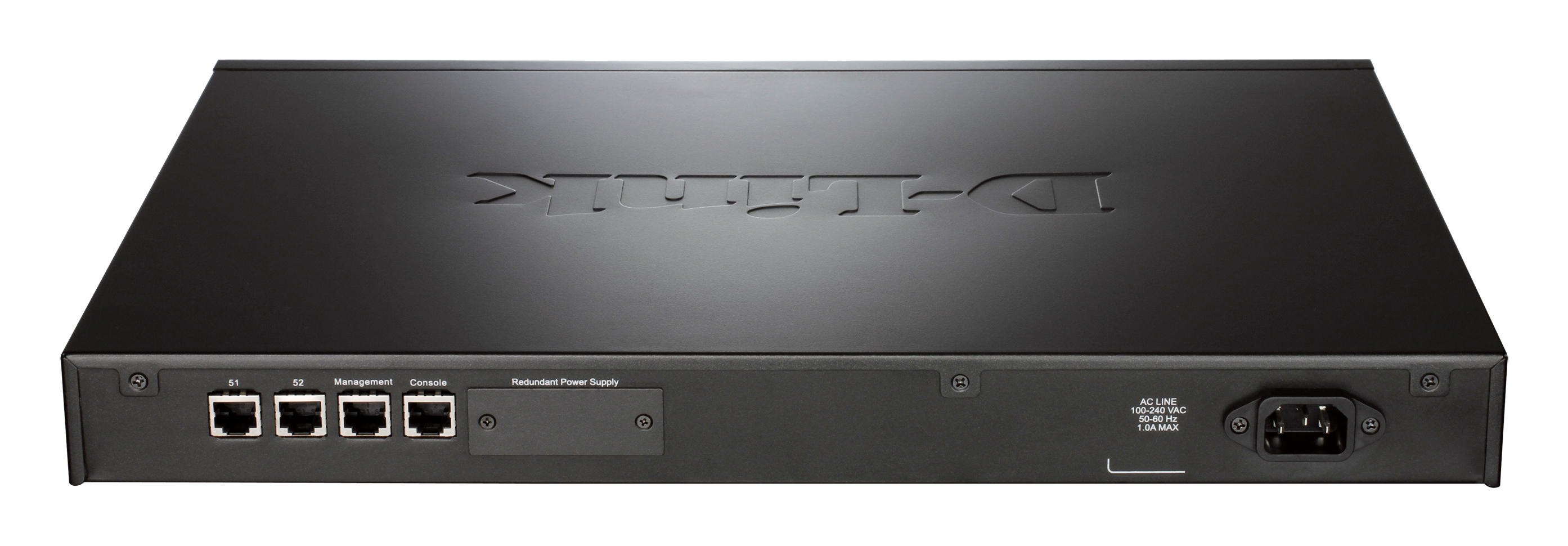48-Port 10/100Mbps + 4 Combo 1000BASE-T/SFP L3 Managed Switch
DES-3810-52 *(This product has been discontinued)
The DES-3810-52 Series 24 and 48-port switches are the latest additions to the D-Link xStack family of nextgeneration, high-end, multi-service Layer 3 switches. The DES-3810-28 provides 24 10/100 Mbps Fast Ethernet ports and 4 combo 1000Base-T/SFP Gigabit Ethernet ports. The DES-3810-52 provides 48 10/100 Fast Ethernet ports, 2 1000Base-T and 2 combo1000Base-T/SFP Gigabit Ethernet ports. The Fast Ethernet ports allow users to connect to other LAN access switches. The combo ports provide users with a much higher level of flexibility for dedicated trunk connections between devices or core switches.
Standard and Enhanced Images
The DES-3810-52 Series is embedded with two different software images - Standard Image (SI) and Enhanced Image (EI). The Standard Image provides sophisticated features for campus or enterprise. It includes advanced Quality of Service (QoS), traffic shaping, 802.1Q tunneling (Q-in-Q), IPv4 routing/multicasting, Ethernet OAM, and various other security features. The Enhanced Image supports IPv6 routing, Border Gateway Protocol (BGP), and Multi Protocol Label Switching (MPLS), which is suitable for next-generation IPv6 networks or VPN/triple play applications in Metro Ethernet. In addition, the Enhanced Image also supports Switch Resource Management (SRM). This allows users to optimize the switch resources for different networking environments.
Enhanced Network Reliability
The DES-3810 Series targets enterprise/campus and customers who require a high level of network security and maximum uptime. The DES-3810-28 and DES-3810-52 both support an external redundant power supply so that continued operation is assured. They also include other features, such as 802.1D Tree (STP), 802.1w Rapid Spanning Tree RSTP) and 802.1s Multiple Spanning Tree (MSTP), Loopback Detection (LBD), and Broadcast Storm Control, that enhance network resilience. The G.8032 Ethernet Ring Protection Switching (ERPS) function minimizes the recovery time to 50 ms. For load sharing and redundancy backup in switch cascading/server attachment configuration, the DES-3810 Series provides dynamic 802.3ad Link Aggregation Port Trunking.
Comprehensive Security
The DES-3810 Series provides users with the latest security features such as Multi-layer and Packet Content Access Control Lists (ACL), Storm Control, and IP-MAC-Port Binding (IMPB) with DHCP Snooping. The IP-MAC-Port Binding feature allows
administrators to bind a source IP address with an associated MAC and also define the port number to enhance user access control. With the DHCP Snooping feature, the switch automatically learns IP/MAC pairs by snooping DHCP packets and saving them to the IMPB white list. In addition, the D-Link Safeguard Engine identifies and prioritizes “CPU interested” packets to prevent malicious traffic from interrupting normal network flows and to protect switch operation.
Identity Driven Network Policies
The DES-3810 Series supports authentication mechanisms such as 802.1X, Web-based Access Control (WAC), and MAC-based Access Control for strict access control and easy deployment. After authentication, individual policies such as VLAN membership, QoS policies, and ACL rules can be assigned to each host. In addition, the switch also supports Microsoft® NAP (Network Access Protection). NAP is a policy enforcement technology that allows customers to protect network assets from unhealthy computers by enforcing compliance with network health policies.
Traffic Management for Triple Play Services
The DES-3810 Series implements a rich set of multilayer QoS/CoS features to ensure that critical network services like VoIP, video conference, IPTV and IP surveillance are served with priority. The Three Color Marker and Traffic Shaping features guarantee the quality of these services when the network is busy. With L2/L3 Multicast support, the DES-3810 shows its ability to handle growing IPTV applications. The Host-based IGMP/MLD Snooping allows multiple multicast subscribers per physical interface and ISM VLAN sends multicast streams in a multicast VLAN to save bandwidth in the backbone network. The ISM VLAN profiles allow users to bind/replace the pre-defined multicast registration information to subscriber ports quickly and easily.
.png)


